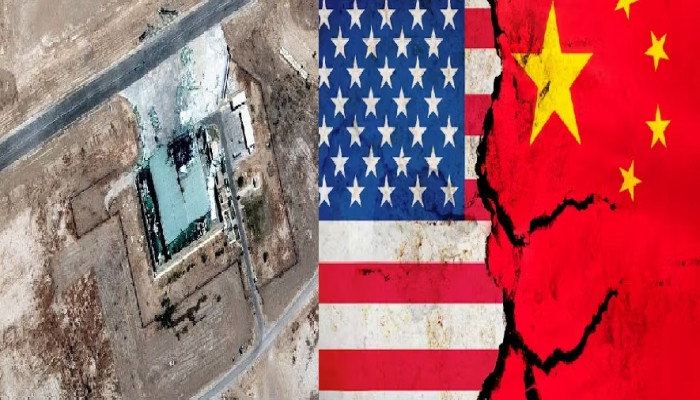China versus United States: Involvement in Nur Khan Airbase
- In Military & Strategic Affairs
- 06:43 PM, Jul 01, 2025
- Viren S Doshi
CCP Failures and Post-failure Infowar
Overview
Nur Khan Airbase, located in Chaklala, Rawalpindi, Pakistan, serves as the headquarters for the Pakistan Air Force’s (PAF) Air Mobility Command.
Facts like Chinese Communist Party (CCP)-occupied China’s supply of approximately 81% of Pakistan’s arms including critical systems at Nur Khan airbase are overshadowed by unsubstantiated allegations of American control of this airbase, amplified by Pakistani left leaning analyst Imtiaz Gul following India’s Operation Sindoor (May 7–10, 2025).
This analytical report examines American versus CCP-occupied China’s involvement at this airbase, the catastrophic failure of CCP-supplied systems during India’s strikes, and the disinformation campaign that followed the attack to deflect blame onto the United States.
The report also notes the implausibility of India targeting a U.S.-manned airbase, given high-level Indo-U.S. communication that continued during the entire operation.
Let us begin with an examination of the American involvement in this base.
American Involvement at Nur Khan Airbase - A Legacy
U.S.-Pakistan military cooperation at Nur Khan (formerly Chaklala) Airbase began in the 1950s with U-2 reconnaissance missions from bases like Badaber. Nur Khan airbase supported U.S. logistics, drone operations and intelligence missions for Afghanistan during the War on Terror (2001–2021). In 2005, approximately 300 U.S. troops and aircraft were deployed to Chaklala for earthquake relief. Claims of American “control” of this base are unsubstantiated, as Pakistan retains operational sovereignty, evidenced by the 2011 U.S. withdrawal from Shamsi Airbase.
Logistical Presence: The U.S. maintains a limited presence at Nur Khan for F-16 maintenance and may be for intelligence, surveillance and reconnaissance (ISR) missions, possibly monitoring the Ayatollah's Regime in Iran or Islamic State Khorasan Province (ISKP).
F-16 Maintenance: The U.S. provides ongoing support for Pakistan’s Lockheed Martin F-16 Fighting Falcon fleet, including a current $398 million aid package for maintenance, likely involving contractual technical advisors at Nur Khan or Jacobabad Airbase. Private contractors at Jacobabad indicate a specialised but limited U.S. role. Their precise role is to oversee the F-16 fleet, that it is not used against India or any sovereign nation and is used only for counter-terrorism purposes.
Claims of U.S. Control: In June 2025, Imtiaz Gul claimed the Nur Khan base is “under American control,” alleging Pakistani officers are barred from interfering, citing frequent U.S. aircraft movements with undisclosed cargo. Neither the U.S. nor the Pakistani governments ever mentioned any such existing agreement or arrangement, suggesting these claims are unsubstantiated and probably misconstrued as American involvement in the F16 fleet maintenance through contractors. No American troops are in Pakistan. Hence, it follows that such claims are likely to have been purposed to fuel anti-U.S. sentiment by left-leaning forces.
Indo-U.S. Coordination during Operation Sindoor: During India's strikes, Indian National Security Advisor (NSA) Ajit Doval and External Affairs Minister (EAM) S. Jaishankar and others were in continuous communication with their American counterparts, including U.S. National Security Advisor and Secretary of State Marco Rubio. The U.S. Vice President also communicated with the Indian Prime Minister. This high-level coordination ensured transparent alignment, making it highly improbable that India would target a base with significant U.S. personnel or control amid such live hot communication between the two democratic allies with a compact strategic relationship. The absence of any reported casualties or protests or retaliation (particularly given the America First commitment of the Trump-Vance Administration) from the U.S. further undermines claims of American operational control at Nur Khan airbase.
No U.S. Air Defences: No evidence suggests U.S.-supplied air defences at Nur Khan, undermining claims of American technological failure. The base’s defences relied entirely on CCP systems, which collapsed under Indian strikes.
CCP-Occupied China’s Arms Supplies to Pakistan
According to the Stockholm International Peace Research Institute (SIPRI), CCP-occupied China supplied 81% of Pakistan’s arms imports from 2020 to 2024, up from 74% in the previous five-year period, making CCP-occupied China Pakistan’s primary arms supplier and possibly a highly dominating supplier for equipment deployed at Nur Khan airbase systems.
Key CCP-occupied China Systems at Nur Khan base:
HQ-9 and HQ-16 Surface-to-Air Missile (SAM) Systems: The HQ-9, a long-range SAM costing $3 million per unit, and the medium-range HQ-16 were deployed to protect Nur Khan airbase. Marketed by the CCP as comparable to U.S. Patriot systems, these understandably miserably failed to intercept India’s BrahMos and SCALP missiles during Operation Sindoor.
Chengdu J-10C Vigorous Dragon Fighters: Pakistan’s No. 15 Squadron at Nur Khan airbase operates J-10C jets, which the CCP claimed downed Indian Dassault Rafale jets. India has not confirmed these claims, and satellite imagery suggests limited PAF air engagement.
Wing Loong Drones: CCP-occupied China's Wing Loong series combat drones supported Pakistan’s unmanned aerial vehicle (UAV) capabilities, with the Nur Khan base as a hub for drone operations. However, these drones failed to dent Indian Systems or installations.
Satellite and Radar Support: CCP-occupied China’s MIZARVISION provided post-strike satellite imagery, while CCP-occupied China redeployed radar systems and adjusted satellite coverage over India to enhance Pakistan’s situational awareness level. Pakistan itself turns into a proxy of the CCP, while its proxy war on India has started costing it dearly.
Post-Conflict Commitments: After Operation Sindoor, CCP-occupied China pledged 40 Shenyang J-35A stealth fighters starting in 2026, HQ-19 ballistic missile defence systems and additional Wing Loong drones to establish a PAF drone brigade, deepening Pakistan’s reliance on CCP arms.
And last, but not least -
Nuclear Assistance: CCP-occupied China has supported Pakistan’s nuclear program with four Chashma reactors and low-enriched uranium, safeguarded by the International Atomic Energy Agency (IAEA), underscoring the CCP’s strategic influence over Pakistan’s military capabilities.
Operation Sindoor and CCP-Occupied China’s Failures
Indian Strikes: Launched in response to the April 22, 2025 Pahalgam terror attack (26 civilian deaths), Operation Sindoor targeted Nur Khan and 10 other airbases (Rafiqui, Murid, Bholari, Jacobabad etc.) with BrahMos supersonic cruise missiles, SCALP air-launched cruise missiles and Harop kamikaze drones. Satellite imagery from MIZARVISION, Maxar Technologies, and India’s KAWASPACE confirmed extensive damage: a 7,000-square-foot complex demolished, two command-and-control trucks destroyed, and runways damaged with huge craters, disrupting 20% of PAF infrastructure, including C-130 Hercules transports and IL-78 refuelers.
CCP-occupied China Systems’ Collapse: The HQ-9 and HQ-16 systems failed to intercept India’s missiles, and an HQ-9 unit at Walton Airport was ineffective against Harop drones. CCP analysts blamed poor Pakistani training, but the systems’ inability to counter advanced Indian munitions exposed their inferiority. Media posts highlighted the HQ-9’s failure to detect low-flying missiles, undermining CCP’s claims of technological parity.
Strategic Fallout: Nur Khan’s proximity to the Strategic Plans Division (SPD), overseeing Pakistan’s nuclear arsenal, made the strikes a major psychological blow. The U.S., anticipating a perceived “decapitation” threat, intervened via Secretary of State Marco Rubio. Finally, the Director Generals of Military Operations (DGMOs) of the two militaries secured a ceasefire on May 10, 2025.
CCP-Occupied China’s Disinformation Campaign - Loser fighting doubly, but losing terribly
False Success Narratives: CCP-controlled media and social media posts of its deep assets claimed J-10C jets downed Indian Rafales, despite no Indian confirmation and minimal evidence of PAF air engagement. This propaganda aims to bolster CCP-occupied China’s $50 billion arms export market, with Pakistan as its largest client, by portraying CCP systems as superior to Western alternatives.
Deflecting Blame: The amplification of unverified claims of U.S. control over Nur Khan, such as Gul’s allegations, is done by leftist media moles to shift focus from CCP failures. By framing the U.S. as compromising Pakistan’s sovereignty, the CCP obscures the HQ-9 and HQ-16’s deficiencies, which were jammed and bypassed by Indian missiles.
Doctored Evidence: A viral video falsely linked to Nur Khan’s damage was debunked as footage from Sudan’s Khartoum Airport (March 2025). Pakistan’s claims of retaliatory strikes on Indian airbases like Adampur were discredited as doctored images (e.g. a cloud shadow mistaken for a bomb crater). And the Indian PM nailed this fakery by visiting the base.
Geopolitical Agenda: The CCP’s $60 billion China-Pakistan Economic Corridor (CPEC) investments, with dual-use potential, underscore its strategic grip on Pakistan. By pushing anti-U.S. narratives, the CCP seeks to deepen Pakistan’s dependency, counter India’s military indigenisation and modernisation and challenge U.S. influence in South Asia.
Conclusion
Nur Khan Airbase remains under Pakistani control, with limited legacy U.S. involvement in F-16 maintenance and ISR.
CCP-occupied China, supplying 81% of Pakistan’s arms, suffered a devastating failure during Operation Sindoor, as its HQ-9 and HQ-16 systems collapsed against Indian strikes.
The CCP’s disinformation campaign, amplifying unverified U.S. control claims and fabricating Pakistani successes, seeks to obscure its technological deficiencies and protect its arms market and geopolitical stakes.
High-level Indo-U.S. coordination during the operation debunks claims of India targeting a U.S.-manned base, highlighting the CCP’s manipulative narratives.
Disclaimer: The opinions expressed within this article are the personal opinions of the author. MyIndMakers is not responsible for the accuracy, completeness, suitability, or validity of any information on this article. All information is provided on an as-is basis. The information, facts or opinions appearing in the article do not reflect the views of MyindMakers and it does not assume any responsibility or liability for the same.







Comments